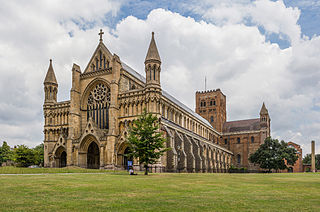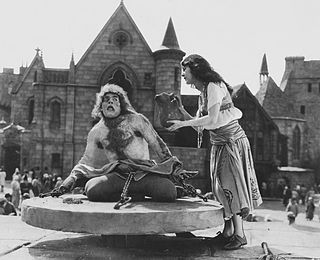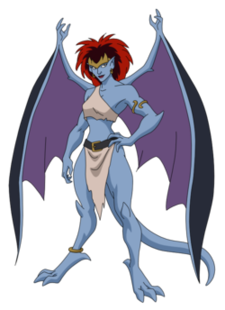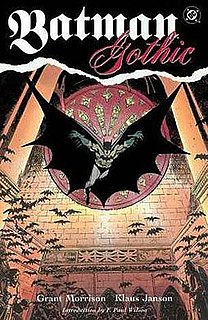
Gothic architecture is a style that flourished in Europe during the High and Late Middle Ages. It evolved from Romanesque architecture and was succeeded by Renaissance architecture. Originating in 12th-century France, it was widely used, especially for cathedrals and churches, until the 16th century.

Notre-Dame de Paris, often referred to simply as Notre-Dame, is a medieval Catholic cathedral on the Île de la Cité in the 4th arrondissement of Paris, France. The cathedral is consecrated to the Virgin Mary and considered to be one of the finest examples of French Gothic architecture. Its innovative use of the rib vault and flying buttress, its enormous and colourful rose windows, and the naturalism and abundance of its sculptural decoration set it apart from the earlier Romanesque style.

St Albans Cathedral, sometimes called the Cathedral and Abbey Church of St Alban, and referred to locally as "the Abbey", is a Church of England cathedral in St Albans, England. Much of its architecture dates from Norman times. It ceased to be an abbey in the 16th century and became a cathedral in 1877. Although legally a cathedral church, it differs in certain particulars from most other cathedrals in England: it is also used as a parish church, of which the dean is rector with the same powers, responsibilities and duties as that of any other parish. At 85 metres long, it has the longest nave of any cathedral in England.

The Cathedral of the Holy Cross and Saint Eulalia, also known as Barcelona Cathedral, is the Gothic cathedral and seat of the Archbishop of Barcelona, Catalonia, Spain. The cathedral was constructed from the thirteenth to fifteenth centuries, with the principal work done in the fourteenth century. The cloister, which encloses the Well of the Geese was completed in 1448. In the late nineteenth century, the neo-Gothic façade was constructed over the nondescript exterior that was common to Catalan churches. The roof is notable for its gargoyles, featuring a wide range of animals, both domestic and mythical.

Gargoyles is an American animated television series produced by Walt Disney Television and distributed by Buena Vista Television, and originally aired from October 24, 1994, to February 15, 1997. The series features a species of nocturnal creatures known as gargoyles that turn to stone during the day. After spending a thousand years in an enchanted petrified state, the gargoyles are reawakened in modern-day New York City, and take on roles as the city's secret night-time protectors.

The Hunchback of Notre Dame is a 1996 American animated musical drama film produced by Walt Disney Feature Animation for Walt Disney Pictures. The 34th Disney animated feature film and the seventh animated film produced and released during the period called the Disney Renaissance, the film is based on the 1831 novel of the same name written by Victor Hugo. The plot centers on Quasimodo, the deformed bell-ringer of Notre Dame, and his struggle to gain acceptance into society. Directed by Kirk Wise and Gary Trousdale and produced by Don Hahn, the film's voice cast features Tom Hulce, Demi Moore, Tony Jay, Kevin Kline, Paul Kandel, Jason Alexander, Charles Kimbrough, David Ogden Stiers, and Mary Wickes in her final film role.

Quasimodo a fictional character and the main protagonist of the novel The Hunchback of Notre-Dame (1831) by Victor Hugo. Quasimodo was born with a hunchback and feared by the townspeople as a sort of monster, but he finds sanctuary in an unlikely love that is fulfilled only in death. The role of Quasimodo has been played by many actors in film and stage adaptations, including Lon Chaney, Sr. (1923), Charles Laughton (1939) and Anthony Quinn (1956), as well as Tom Hulce in the 1996 Disney animated adaptation, and most recently Michael Arden in the 2016 stage musical adaptation. In 2010, a British researcher found evidence suggesting there was a real-life hunchbacked stone carver who worked at Notre Dame during the same period Victor Hugo was writing the novel and they may have even known each other.

A pinnacle is an architectural ornament originally forming the cap or crown of a buttress or small turret, but afterwards used on parapets at the corners of towers and in many other situations. The pinnacle looks like a small spire. It was mainly used in Gothic architecture.

Demona,, voiced by Marina Sirtis, is a fictional character and one of the primary antagonists of the Disney animated television series Gargoyles. Demona was once Goliath's mate and was part of their 10th century AD castle's Wyvern Clan. She is consumed by a hatred of humanity and has attempted several times to destroy it.

MonseigneurClaude Frollo is a fictional character and the main antagonist of Victor Hugo's 1831 novel The Hunchback of Notre-Dame. He is the Archdeacon of Notre Dame.

The Hunchback of Notre Dame II is a 2002 American animated romantic musical comedy-drama film and direct-to-video sequel to the 1996 Disney animated film The Hunchback of Notre Dame. It was produced by Walt Disney Animation Japan, Walt Disney Television Animation and Walt Disney Video Premiere. Unlike many Disney film sequels, almost the entire key cast of the first film returned. It has a 30% approval rating on Rotten Tomatoes.
Gargoyle is a name shared by two fictional characters appearing in American comic books published by Marvel Comics.

The Cathedral of Braga is a Roman Catholic church in the northern city of Braga, Portugal. Due to its long history and artistic significance, it is also one of the most important buildings in the country. It is the seat of the Archdiocese of Braga and of the Primate Archbishop of Portugal.

Gothic, also known as Gothic: A Romance, is a 1990 Batman comic book storyline that ran through the Legends of the Dark Knight monthly series and was later compiled into trade paperback form. It was written by Grant Morrison and illustrated by Klaus Janson.

Bordeaux Cathedral is a Roman Catholic church dedicated to Saint Andrew and located in Bordeaux, France. It is the seat of the Archbishop of Bordeaux.

French Gothic architecture is a style which emerged in France in 1140, and was dominant until the mid-16th century. The most notable examples are the great Gothic cathedrals of France, including Notre Dame Cathedral, Chartres Cathedral, and Amiens Cathedral. Its main characteristics were the search for verticality, or height, and the innovative use of flying buttresses and other architectural innovations to distribute the weight of the stone structures to supports on the outside, allowing unprecedented height and volume, The new techniques also permitted the addition of larger windows, including enormous stained glass windows, which filled the cathedrals with light. The French style was widely copied in other parts of northern Europe, particularly Germany and England. It was gradually supplanted as the dominant French style in the mid-16th century by French Renaissance architecture.

Heavenly Pursuits is a 1986 Scottish comedy film written and directed by Charles Gormley and starring Tom Conti, Helen Mirren, and David Hayman. Set in Glasgow, Scotland, the film is about a teacher at a Catholic school whose students are searching for two more miracles that would promote the late Edith Semple to sainthood. A nonbeliever himself, the teacher's scepticism is challenged when he becomes involved in seemingly miraculous events.
Wendreda, also known as Wendreth, was an Anglo-Saxon nun, healer, and saint, perhaps of the 7th century. She was uncertainly reported as a daughter of King Anna of East Anglia, a Christian king, which would make her a sister of Etheldreda, abbess of Ely, Sexburgha, abbess of Minster-in-Sheppey, and Ethelburga, abbess of Faremoutiers, who are all better-known saints, and a half-sister of Sæthryth, also an abbess of Faremoutiers.


















